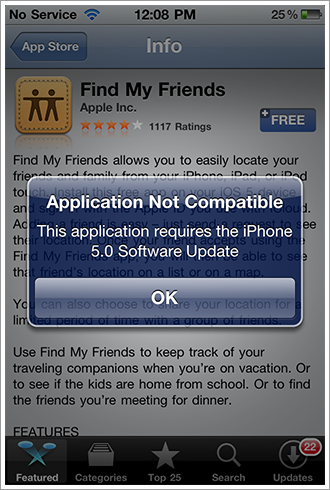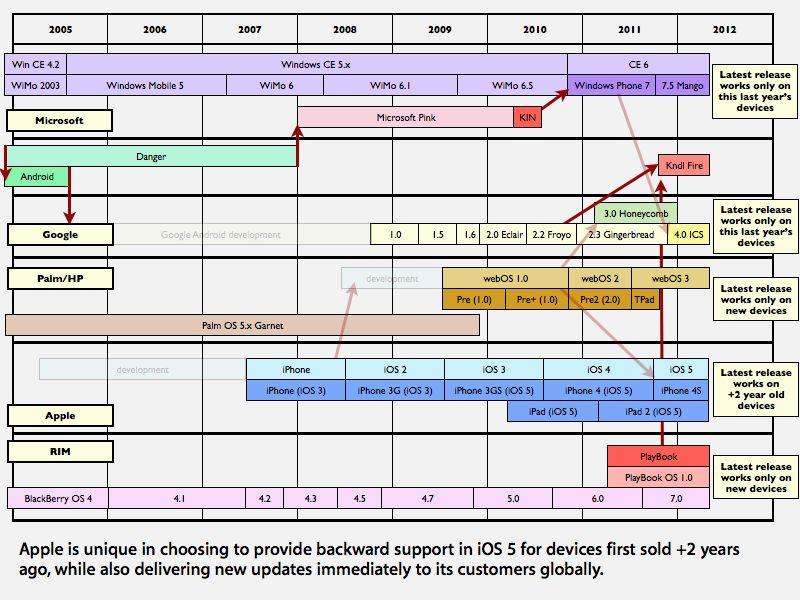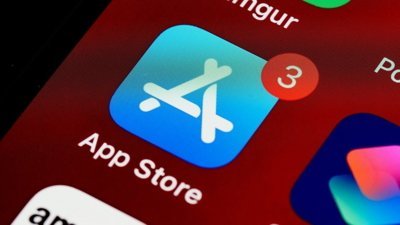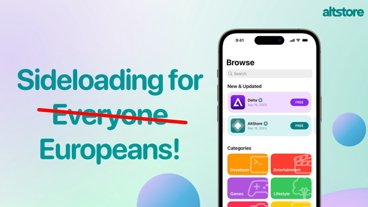Apple aggressively pushing iOS 5 deployment to users
Unlike other mobile platforms, Apple has retained control of the iOS software update cycle rather than allowing mobile carriers to inject themselves into the update process via their typical practice of "over the air" mobile device upgrades. Carriers, along with hardware makers, have historically complicated software updates with their own customizations, frequently delaying the upgrade process for their users by months after the OS vendor releases a new version.
Apple's latest iOS 5 update now incorporates "over the air" upgrades, but does so directly from the phone to Apple's servers rather than relying upon carriers to deploy the updates. The company is initially deploying iOS 5 via iTunes, as existing versions of Apple's mobile OS can't perform a wireless update.
As has been the case in previous updates, the relative ease of Apple's direct update process, and the immediately availability of iOS 5 for models dating back to 2009 has resulted in the new software already accounting for 20 percent of the installed base on Chitika's ad network having installed the upgrade within just the first five days of its release, the advertising firm announced yesterday.
In contrast, based on Google's latest reported figures, it appears to have taken about seven months to update a similar 20 percent proportion of the active installed base of Android users to last winter's most recent reference release of Android 2.3 Gingerbread. In part, that's because even among some of the most popular Android handsets, there was no upgrade to Gingerbread available until this month.
The Importance of Being Updated Earnestly
Apple's ability to rapidly roll out new updates to the vast majority of its customers globally through voluntary updates means that iOS developers can trim their coding and testing efforts related to previous iOS versions, and quickly adopt the new features and development aspects of the latest operating system.
That makes it easier for developers to support new features such as iCloud (in addition to the fact that iCloud accounts are now included for free), as developers observe that the majority of users will not only be able to take advantage of the new cloud storage and document management features, but will be clamoring for such support. Other features, including Twitter integration, can also be rolled out with confidence.
Additionally, without any significant platform fragmentation developers can rapidly adopt new development tools and technologies Apple has released as part of iOS 5, including UI Storyboards for planning apps in Xcode, UIKit customization for creating apps that reflect a custom appearance, and Automatic Reference Counting for more efficient, semi-automatic management of memory allocation. Developers can also employ the latest APIs, knowing that virtually their entire audience will already have iOS 5 installed.
The reduced busy work for developers allows them to devote more of their efforts into making better apps with greater functionality and sophistication for their customers. Apple benefits from a stronger App Store library and users benefit from less complication in shopping for apps and a wider variety of better apps.
Free as in beer
Apple has worked to make it easy for existing iOS users to upgrade, and even essential for running its own latest apps, such as the new Find My Friend app. Attempting to install the new app without updating to iOS 5 results in a warning, as noted in a blog post by developer Appcubby and pictured below.
From the original debut of iPhone in 2007, Apple has pushed to make the latest releases of its mobile operating system widely available, even constructing a subscription method of accounting for the iPhone to ensure that its planned series of regular software updates wouldn't run afoul of US accounting rules, which mandate that products that are improved over time not have their revenue booked up front until the planned value is actually delivered.
Apple's subscription accounting of the iPhone, which deferred a large part of its iPhone revenues over the phone's lifespan, had the initial side effect of obscuring part of the commercial success of the new device in Apple's initial quarterly earnings, but it allowed Apple to push regular, rapid updates incorporating new features and functionality, to its new users, attracting development and progressively building a dynamic ecosystem around the product.
In contrast, the company didn't pursue the same strategy with its iPod touch, and instead charged a nominal fee for iOS updates on that device. The result was that while iPhone users regularly and promptly updated their phones to the newest software, a large proportion of iPod touch users didn't, demonstrating the significant barrier of even a $10 upgrade fee in getting people to accept rapidly evolving new technology.
A case for open and closed
In parallel with Apple's proprietary but free iOS updates, Google and Microsoft developed their own competing strategies for managing their mobile platforms, with Google leading an open source effort to develop Android as a platform anyone could obtain and tinker with, while Microsoft originally attempted to sell upgrades of its Windows Mobile platform in the model of Windows OS releases for PC users.
Neither Microsoft nor Google were making any money from hardware sales as Apple did. Microsoft only earned minor licensing fees from its hardware partners while Google reportedly subsidized at least some licensees to get them to adopt Android, a so called "less than free" model that was regarded as potentially "disruptive" in 2009.
Microsoft's retail upgrade model for Windows Mobile didn't work out, as few users opted to buy upgrades. In many cases, every new major release of Windows Mobile advanced its requirements to the point where it couldn't really run on any existing phones anyway. Google's Android, on the other hand, rapidly replaced existing free or low cost alternatives (such as Linux paired with Java) among smartphone makers.
However, by Android's third generation, Google realized that free and open updates were difficult to sustain from a marketing and operational perspective, resulting in the company closing the development of Android 3.0 Honeycomb and refusing to make its code available to smartphone users who wanted to play with the new tablet-oriented release on their devices.
The development of Android 4.0 Ice Cream Sandwich was similarly closed, with Google working only with a limited number of partners on the new release in order to deliver a distinguished launch of specific new models, including the Samsung-built Galaxy Nexus.
Android 4.0 upgrades
However, the result of Google's new closed development model for Android is that licensees and carriers will now have even less time to prepare to deploy Android 4.0 updates. So even though Google distributes Android for free, Android users who should be able to upgrade their phones to Android 4.0 are unlikely to actually get it any sooner than the typical minimum of a three to six month waiting period that has occured with previous releases of last year's Froyo or Gingerbread.
Google and its partners also have demonstrated less interest than Apple in supporting the majority of their installed base with the latest OS updates. While iOS 5 was made available on day one for all Apple devices released in 2009 or later, Google has indicated that only brand new devices will have any hope of upgrading Android 4.0, even leaving unanswered whether last year's Google Nexus One would get an update.
Google's Gabe Cohen reportedly told
So, while Apple is rapidly pushing to upgrade its entire installed base to iOS 5 as quickly as possible, Google hasn't even articulated plans to support its own iPhone 4-era model with Android 4.0, and the majority of Android phones sold this winter won't ship with, or immediately be upgradable to, Google's latest OS update.
That's not a new development, as many Android licensees have only recently deployed last year's Android updates on even their most popular Android models. For example, HTC and Verizon didn't update the very popular Droid Incredible (which in April Engadget called "the best Android device that you can purchase in America right now") to Android 2.2 Froyo until August (at which point the OS release was over a year old), and then didn't even begin to release Android 2.3 Gingerbread for it until September. Many users were still waiting for the update into October, by which time the release was again nearly a year old.
If Apple followed a similar upgrade program, iPhone 4 and iPad users would just now be getting the features of iOS 4, including Folders and Game Center.
Windows Phone, BlackBerry, webOS updates
Other platforms aren't faring much better than Android in rapidly rolling out support for new features of new operating system releases. RIM announced this summer that its latest BlackBerry OS 7 would not be made available for any existing devices, even new models that shipped weeks before the release.
In February, HP announced that it wouldn't be delivering its latest webOS 2.0 (as originally promised) for last year's webOS phones released alongside iPhone 4.
Microsoft erased all backwards compatibility support for Windows Phone 7 on its current crop of Windows Mobile 6.x devices when it launched its new OS last winter. Starting with WP7, Microsoft has followed Apple's strategy of bypassing mobile carriers to deliver new updates itself. However, it hasn't been able to deliver updates with nearly the same speed or efficiency as Apple. The company just announced that for "three weeks we’ve been watching quality while sending update notices to a growing fraction of phones" for Windows Phone 7.5 Mango, the first major update.
Microsoft began releasing the update at the end of September, but while saying it is now "fully opening the spigot" on delivering updates, there are still phone models in the US that are listed as still being in the "testing" (Samsung Focus 1.4) or "planning" stages (Dell Venue Pro), while internationally the Samsung Omnia 7 is still in "testing" stages on two carriers.
That indicates that Microsoft's update system isn't quite as simple as Apple's, which had pioneered the concept of using desktop computers to update the iPhone as easily as the company had been updating iPods. Another aspect strongly favoring Apple's business model is the lack of a wide variety of different hardware models to support, an issue Microsoft attempted to address through strict rules defining minimum standards for Windows Phone 7 devices.
 Daniel Eran Dilger
Daniel Eran Dilger













 Malcolm Owen
Malcolm Owen
 William Gallagher
William Gallagher

 Sponsored Content
Sponsored Content



 Christine McKee
Christine McKee






